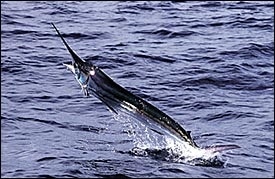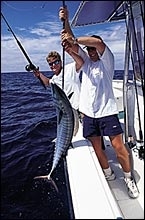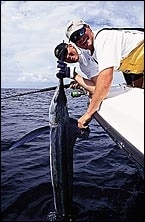
| Autumn brings hordes of acrobatic white marlin – and the anglers who chase them – to the deep-water hot spots off northwest Florida. |
Driven by dreams of white marlin, the author and his crew trekked north to fish the waters off the Florida Panhandle. What they found was an offshore hot spot right in America’s own backyard.
For a number of years, my friend Steve Ennis – the noted king mackerel ace from Pensacola – has been telling me about the tremendous white marlin fishing off the Florida Panhandle. Steve mentions the incredible numbers of whites that Panhandle boats encounter with such nonchalance that it’s sometimes hard to take him seriously. That’s probably because he’s so focused on kingfish and the SKA trail that all other fish pale in comparison. Who wants to waste time with white marlin when there are kingfish tournaments to win?
Now don’t get me wrong. I like kingfish as much as the next guy, but I’ve caught a whole bunch of them and not nearly enough white marlin, so the stories finally got to me and I headed for Pensacola last fall. I had a top-notchcrew with me, including Islamorada charter boat professionals Billy Wood and Ben Ekblom, along with fishing buddy Charlie Von Deck.

Captain Billy Wood, right, and Ben Ekblom double-team a wahoo that chomped a ballyhoo. Good thing they rigged with wire!|
We arrived in the middle of a major cold front that caused air and water temperatures to plummet. When the weather finally broke, we headed offshore and began fishing in cold, green water – with no success. The fleet was spread out in similar depths over a 30-mile range, looking for the fish in an area where the white marlin bite had been unbelievable just a few days before.
Now the fish were gone. The radio crackled with sporadic reports of a single fish here and there, but overall the action was dead. Then we heard a faint transmission from a boat that was obviously far away, but through the broken dialogue I clearly heard the words, “ten whites.” The crew huddled around the VHF speaker as I turned the squelch all the way down, and we all strained to hear the conversation. It came in weak, but readable. A boat had had ten white marlin shots, and it was not yet 10:00 a.m.!
“Tell us where you are!” we all thought, and finally the precious information came through. He was at a spot called the Spur, some 50 miles offshore on the 300-fathom curve. We fell over one another trying to retrieve the chart we had purchased the afternoon before. In what direction was the Spur? More importantly, how far away was it? Latitude and longitude were hastily punched into the GPS and it spit the numbers out – 32 nautical miles south. Without a word, all lines were reeled in, and in short order we were running hard.
White in Sight
It seemed to take forever to get there, but as we neared the Spur we encountered a totally different ocean from the one we had left. The water turned cobalt blue and was almost two degrees warmer. Weed lines and rips appeared, and birds were circling overhead. This was more like it.
We decided to start fishing five miles short of the Spur. No sooner had we come off plane than Ekblom pointed to starboard and shouted, “There’s one right there!”
Sure enough, a white was tailing lazily down-sea not more than 30 yards from where we had stopped. Ben and Billy quickly fired rigged ballyhoo over the side as I swung the boat around to intercept the fish, and it was only a few seconds before the marlin rose below the right bait, its pectoral fins lit up a brilliant neon blue.
The next few minutes were a blur, but the sort of blur offshore fishermen live for. The white would rise to the bait, engulf it in a swirl of white water, and whoever was on the rod would drop back. “I got him this time!” the angler would shout each time, only to come up slack when he wound down. White marlin can drive you crazy like that, but that’s why they’re so much fun.

Small ballyhoo, fished naked or behind lures, are a top bait of Panhandle trollers. They’ll take a variety of species.|
The fish rose again and again, and three people baited it five different times before Billy finally fired out yet another ballyhoo on a spinning rod. As before, the fish ate the naked bait and swam off while he free-spooled line. However, this time the rod bent over when he wound down, and a frantically jumping white was suddenly twisting in the air behind the boat.
White marlin have to be among the most acrobatic of fishes, and this one was no exception. It put on a spectacular aerial show and made a couple of blistering runs, but it was hooked solid and Billy soon had it alongside. After some photographs and a lot of high-fives, we revived the fish and watched it swim off.
Action Close In
Catching that marlin was the highlight of a great trip, albeit one that had gotten off to a slow start. The aforementioned front had disrupted some truly awesome white marlin action relatively close to shore. The week before we arrived in Pensacola, the whites had been schooled up well inside the 100-fathom curve, with some boats finding them as close as 20 miles out.
But the influx of green water had shut down the bite, and we spent a full day without a knockdown working the 100-fathom curve to the southwest towards another hook in the curve known as the Elbow, this one being about 41 miles from Pensacola Pass. Lots of other fishermen worked these waters with little success, including Steve Ennis and Captain Tom Hardy aboard a beautiful 35-foot Cabo called the Mega Bites. It took one adventurous skipper to work his way farther out and find the fish.
Most Panhandle anglers pull rigged natural baits for whites. Ballyhoo, small swimming mullet, and squid are all great choices, but we chose to go with small ballyhoo rigged naked on No. 7 wire with 7/0 Mustad 3412C hooks. We used wire because the northern Gulf of Mexico is also known for great wahoo fishing. It turned out to be a smart choice.

Ben Ekblom shows off Billy Wood’s white marlin taken near the Spur on 20-pound spinning gear.|
Just a few minutes after we released the white marlin, we resumed our southward trolling and came upon a giant rip and a weed line less than half a mile away. All four lines were attacked by hordes of decent-sized schoolie dolphin, and as we reeled them in we noticed a pack of six or more wahoo swimming along right behind the boat!
Ben quickly dropped back a ballyhoo, then began reeling furiously, and the lead wahoo attacked. Charlie and I did the same and immediately hooked up as well. The wahoo stayed with the boat, and we caught one after the other for half an hour. It was my first experience with sight-fishing for wahoo, and one I hope to repeat.
Autumn is Prime Time
According to Ennis, Hardy and Jerry Andrews, owner of Beach Marina in Pensacola (see sidebar), the white marlin show up off the Panhandle in September as the water cools somewhat from the heat of summer. Ironically, late summer is a great time to find blue marlin in the northern Gulf, and September is when you might encounter outstanding numbers of both species. The white bite peaks in October, then drops off in November as the first cold fronts arrive.
You can fish the areas mentioned in this article from lots of different ports, of course. Panama City, Destin, Pensacola and Orange Beach, Alabama, are all within striking distance, but Pensacola is the most centrally located. Excellent charter fleets work out of these towns, or you can try it on your own, as we did.
Like most places, local knowledge is vital for success, but guys like Jerry Andrews can point you in the right direction, or take you there themselves. Additionally, the offshore fleet is very good about sharing information on the radio. Just check with the locals to find out what’s going on.
Florida’s Panhandle is easily accessible, and hotel, dockage and charter rates are reasonable. Best of all, the offshore action in the fall can be spectacular, with white marlin leading the parade. What more could you ask for? As for being a prime white marlin destination, the area may not be mentioned in the same breath as Venezuela, but that could change as more people discover the incredible action off Pensacola. I’m certainly planning to be there between cold fronts this fall.
| ### Pensacola Travel InformationWhether you plan to fish in your own boat or charter one, Beach Marina in Pensacola Beach (877) 650-FISH; www.fishpensacola.com] has everything you need. This full-service marina that sells fuel, bait, tackle, ice and has transient dockage for boats to 85 feet in length. There’s also a convenient Comfort Inn, (850) 934-5400, right next door. Beach Marina also has a grocery store, a deli, and a full restaurant on site, plus a fleet of 15 charter boats. The marina is located on the south side of the Bob Sikes Bridge on Little Sabine Bay.Marina owners Jerry Andrews and Chuck Nicholson also happen to be excellent sources of information. They even put us onto several schools of huge redfish in Pensacola Bay while the passing cold front made fishing offshore impossible.Gulf Breeze Bait and Tackle, (850) 932-6789, is another great place to gather some local knowledge. To find your way around, get a copy of the “Offshore and Oil Rig Fishing Chart” published by the Coastal Mapping Company of Theodore, Alabama, (334) 653-6898. It’s a laminated chart covering the northern Gulf of Mexico from South Pass, Louisiana, to Destin Pass, Florida. It lists numerous offshore waypoints in both TDs and lat/lon, and offers a wealth of information. – John Brownlee |









